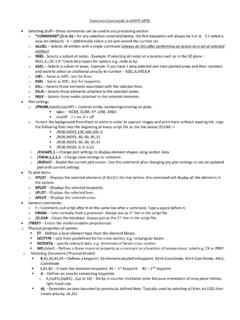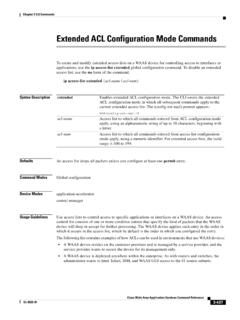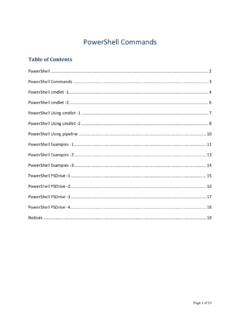Transcription of Linux Commands – Red Hat Specific - The Westbrooks
1 1 Linux Commands Red Hat Specific Windows Linux General Commands dir dir /ad attrib h sorting ls ls filename or file* ls directory or dir* ls l - Directory listing with long filenames, owner, and permissions ls ld - Show only the directories matching the search ls R - Show subdirectories also ( just like dir /s ) ls al ls Sharl sort by size, all files, including hidden ls lart sort by date, reverse order (newest @ the bottom of list) -S - sorts by size, largest first -r - reverses any sort command , ls rS sorts smallest first -t - sorts by modification time, recent first -u - sort by last accessed time -x - sort by file extension Remember Linux is case sensitive, so if you re looking for a file beginning with Vol, type ls Vol* Colors: Blue = directory Green = script Grey = file dir filename* /s | more find depth iname filename* | less - this will find anything starting with filename, with the iname switch allowing it to be case insensitive, and will pipe the results to the less screen so you can page through the results using [Page Up] and [Page Down] keys.
2 Pretty cool! Press Q to quit attrib chmod md mkdir rd rmdir del rm i (without the i, rm will not ask for confirmation) deltree rm rf * copy cp i (without the i, cp will not prompt for destructive actions like file replacement - if the file exists, it is overwritten) How to copy all files from a CD and then change the files to read/write mount /dev/cdrom /mnt/cdrom mkdir /root/snortinstall cp r -v /mnt/cdrom/* /root/snortinstall cd /root/snortinstall chmod R +wr /root/snortinstall/* umount /mnt/cdrom 2copy con cp /dev/tty filename then CTRL+D to quit edit vi or joe type cat move mv ren mv cls clear help man command fdisk fdisk or cfdisk diskcopy To make a copy of a floppy diskette, insert the source and execute.
3 Dd if=/dev/fd0 of=/tmp/floppy bs=1024 count=1440 ..then insert the destination and execute: dd if=/tmp/floppy of=/dev/floppy bs=1024 count=1440 ver cat /etc/redhat-release shows Red Hat version ls /lib/modules - this will show the kernel version of all kernels installed (you could have more than one to boot to) uname sr this will show your current running version uname a shows all the versioning information, except the distribution (Red Hat) whoami finger finger l (most information) w users set set displays system environment. Pipe set to the less command in order to read all of it. set | less Help man info command help HOWTOs , Hard drive info hdparm i /dev/hda Reboot shutdown r now or shutdown rf now (stands for right fu**ing now) reboot (reboot is not clean, do not use often) Shutdown shutdown h now or or halt (halt is not clean, can be bad on disks) Working directory pwd - shows the full path of your current directory Compile binary gcc o <binary name> <.
4 C file> Make Executable out of script chmod +x filename Running Processes, Uptime, etc. top Find a Specific process ps ax | grep process_name ps ax | grep snort Mem free t 3 Login as another user su username Login as another user AND get their path awesome! su username See bootup messages after booting dmesg Display a calendar cal month year Startup file / Disk Space df h Directory Usage du h Install RPM rpm ivh This installs a given rpm with install, verbose, and hash marks To list all installed rpms: rpm qa | sort | more This will list all installed rpms, sort alphabetically, and display them one screen at a time. You could redirect it to a file to peruse at your convenience or for auditing purposes. GRUB boot files /boot/ /boot/ Path To see your path, type echo $PATH Net Send You can send messages to other users that are connected to the same Linux box, such as on the console or SSH d to the box.
5 First, find out what TTY the user is connected to by simply typing w Now, issue the write command to the username and the TTY they are on, like this: write root tty1 Now you can simply type away, hitting the [ENTER] key to send the line. You can keep on typing and sending messages until you escape out by using [CTRL]+c. mail Edit the /etc/ file to put in your SMTP server: vim /etc/ Search for the following line: # "Smart" relay host (may be null) DS Change DS to MD5 CheckSum md5sum filename 4 Directory Size How to find - Size of a directory & Free disk space This article explains 2 simple Commands that most people want to know when they start using Linux . They are finding the size of a directory and finding the amount of free disk space that exists on your machine.
6 The command you would use to find the directory size is ' du '. And to find the free disk space you could use ' df '. All the information present in this article is available in the man pages for du and df. In case you get bored reading the man pages and you want to get your work done quickly, then this article is for you. - 'du' - Finding the size of a directory $ du Typing the above at the prompt gives you a list of directories that exist in the current directory along with their sizes. The last line of the output gives you the total size of the current directory including its subdirectories. The size given includes the sizes of the files and the directories that exist in the current directory as well as all of its subdirectories. Note that by default the sizes given are in kilobytes. $ du /home/david The above command would give you the directory size of the directory /home/david $ du -h This command gives you a better output than the default one.
7 The option '-h' stands for human readable format. So the sizes of the files / directories are this time suffixed with a 'k' if its kilobytes and 'M' if its Megabytes and 'G' if its Gigabytes. $ du -ah This command would display in its output, not only the directories but also all the files that are present in the current directory. Note that 'du' always counts all files and directories while giving the final size in the last line. But the '-a' displays the filenames along with the directory names in the output. '-h' is once again human readable format. $ du -c This gives you a grand total as the last line of the output. So if your directory occupies 30MB the last 2 lines of the output would be 30M . 30M total 5 The first line would be the default last line of the 'du' output indicating the total size of the directory and another line displaying the same size, followed by the string 'total'.
8 This is helpful in case you this command along with the grep command to only display the final total size of a directory as shown below. $ du -ch | grep total This would have only one line in its output that displays the total size of the current directory including all the subdirectories. Note : In case you are not familiar with pipes (which makes the above command possible) refer to Article No. 24 . Also grep is one of the most important Commands in Unix. Refer to Article No. 25 to know more about grep. $ du -s This displays a summary of the directory size. It is the simplest way to know the total size of the current directory. $ du -S This would display the size of the current directory excluding the size of the subdirectories that exist within that directory. So it basically shows you the total size of all the files that exist in the current directory.
9 $ du --exculde=mp3 The above command would display the size of the current directory along with all its subdirectories, but it would exclude all the files having the given pattern present in their filenames. Thus in the above case if there happens to be any mp3 files within the current directory or any of its subdirectories, their size would not be included while calculating the total directory size. - 'df' - finding the disk free space / disk usage $ df Typing the above, outputs a table consisting of 6 columns. All the columns are very easy to understand. Remember that the 'Size', 'Used' and 'Avail' columns use kilobytes as the unit. The 'Use%' column shows the usage as a percentage which is also very useful. $ df -h Displays the same output as the previous command but the '-h' indicates human readable format.
10 Hence instead of kilobytes as the unit the output would have 'M' for Megabytes and 'G' for Gigabytes. Most of the users don't use the other parameters that can be passed to 'df'. So I shall not be discussing them. I shall in turn show you an example that I use on my machine. I have 6actually stored this as a script named 'usage' since I use it often. Example : I have my Linux installed on /dev/hda1 and I have mounted my Windows partitions as well (by default every time Linux boots). So 'df' by default shows me the disk usage of my Linux as well as Windows partitions. And I am only interested in the disk usage of the Linux partitions. This is what I use : $ df -h | grep /dev/hda1 | cut -c 41-43 This command displays the following on my machine 45% Basically this command makes 'df' display the disk usages of all the partitions and then extracts the lines with /dev/hda1 since I am only interested in that.
![Unix Commands [pdf] - Carnegie Mellon University](/cache/preview/1/9/d/8/8/7/a/6/thumb-19d887a6549337a2512a4a299b61c163.jpg)






